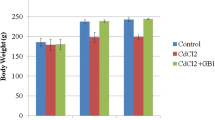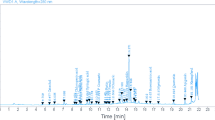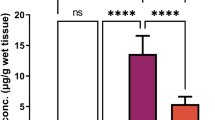Abstract
Guaraná (Paullinia cupana) is an Amazonian plant. Its antioxidant potential was demonstrated to be due to the high polyphenol concentration. On the other hand, one of the mechanisms underlying cadmium-induced cellular damage is free radical mediated, resulting in increased oxidative processes. This study investigated P. cupana’s potential to attenuate cadmium-induced damages in Wistar rat testis. Adult male Wistar rats were either pre-treated with 2 mg/g body weight (BW) of powdered P. cupana seed during 56 days and/or injected with cadmium chloride at a dose of 1.15 mg/kg BW. After cadmium exposition (48 h), testes samples were evaluated by histological and stereological analyses. Both groups exposed to cadmium presented evident morphological alterations relative to control animals. A few rodents showed massive cell death in the seminiferous epithelium and intertubular space, indicating that some animals are more sensitive to cadmium. Despite the alterations observed in both groups, pre-treatment with P. cupana was effective in attenuating morphological changes in Leydig cells, as well as reducing inflammatory response, relative to animals exclusively exposed to the metal. Animals treated only with P. cupana presented a significant increase in plasma testosterone levels and a significant increase in volumetric proportions of seminiferous tubules, which are indicative of spermatogenic stimulation.



Similar content being viewed by others
References
Henman AR (1982) Guaraná (Paullina cupana Var. sorbilis): ecological and social perspective on an economic plant of the central Amazon basin. J Ethnopharmacol 6:311–338
Henman AR (1986) Vida natural—O guaraná: Sua cultura, propriedades, formas de preparação e uso. Global/Ground, 2nd edn.: 77
Espínola EB, Dias RF, Mattei R, Carline EA (1997) Pharmacological activity of guaraná (Paullina cupana) in laboratory animals. J Ethnopharmacol 55:223–229
Bydlowski SP, Yunker RL, Subbiah MTR (1988) A novel property of an aqueous guaraná extract (Paullinia cupana). Inhibition of platelet aggregation in vitro and in vivo. Braz J Med Biol Res 21:535–538
Campos AR, Barros AIS, Santos FA, Rao VSN (2003) Guaraná (Paullina cupana Mart.) offers protection against gastric lesions induced by ethanol and indomethacin in rats. Phytother Res 17:1199–1202
Brekhman II (1980) Man and biologically active substances: the effects of drugs, diet and pollution on health. Pergamon, New York
Carlson M, Thompson RD (1998) Liquid chromatographic determination of methylxanthines and catechins in herbal preparations containing guaraná. AOAC International 81:691–701
Galato D, Ckless K, Susin MF, Giacomelli C, Ribeiro do Valle RM, Spinelli A (2001) Antioxidant capacity of phenolic and related compounds: correlation among electrochemical, visible spectroscopy methods and structure-antioxidant activity. Redox Rep 6:243–250
Mattei R, Dias RF, Spínola EB, Carline EA, Barros SBM (1998) Guaraná (Paullina cupana): toxic behavioral effects in laboratory animals and antioxidant activity in vitro. J Ethnopharmacol 60:111–116
Haslam E (1996) Natural polyphenols (vegetable tannins) as drugs: possible modes of action. J Nat Prod 59:205–215
Halliwell B, Gutteridge JMC (1999) Free radical in biology and medicine. Clarendon, Oxford
Sarkar S, Yadav P, Bhatnagar D (1998) Lipid peroxidative damage on cadmium exposure and alterations in antioxidant system in rat erythrocytes: a study with relation to time. Biometals 11:153–157
Acharya UR, Mishra M, Patro J, Panda MK (2008) Effect of vitamin E and C on spermatogenesis in mice exposed to cadmium. Reprod Toxicol 25:84–88
Koyuturk M, Yanardag R, Bolkent S, Tunali S (2006) Influence of combined antioxidants against cadmium induced testicular damages. Environ Toxicol Pharmacol 21:235–240
Friberg L, Kjellstrom T, Nordberg GF (1986) Cadmium. In: Friberg L, Nordberg GF, Vouk V (eds) Handbook on the toxicology of metals. Elsevier, Amsterdam, pp 130–184
WHO—World Health Organization (1992) Cadmium—environmental aspects. (Environmental Health Criteria: 135). WHO—World Health Organization, Geneva
Burukoglu D, Bayçu C (2008) Protective effects of zinc on testes of cadmium-treated rats. Bull Eviron Contam Toxicol 81:521–524
Yano CL, Dolder H (2002) Rat testicular structure and ultrastructure after paracetamol treatment. Contraception 66:463–467
Fukumasu H, Silva TC, Avanzo JL, Lima CE, Mackoviak II, Atroch A, Spinosa HS, Moreno FS, Dagli MLZ (2005) Chemopreventive effects of Paullina cupana Mart. Var. sorbilis, the guaraná, on mouse hepatocarcinogenesis. Cancer Lett 20:1–7
Russel LD, Ettlin RA, Hikim APS, Clegg ED (1990) Histological and histopathological evaluation of the testis, 1st edn. Cache River, Clearwater
Mori H, Christensen K (1980) Morphometric analyses of Leydig cells in the normal rat testis. J Cell Biol 84:340–354
Russel LD, França LR (1995) Building a testis. Tissue Cell 27:129–147
Hew KH, Ericson WA, Welsh MJ (1993) A single low cadmium dose causes failure of spermiation in rat. Toxicol Appl Pharmacol 121:15–21
Blanco A, Moyano R, Flores-Acuña R, Molina A, Blanco C, Garcia-Flores JR, Espada M, Monterde JG (2009) Quantitative study of Leydig cell populations in mice exposed to low doses of cadmium. Bull Eviron Contm Toxicol 82:756–760
Blanco A, Moyano R, Vivo J, Flores-Acuña R, Molina A, Blanco C, Agüera E, Monterde JG (2007) Quantitative changes in the testicular structure in mice exposed to low doses of cadmium. Environ Toxicol Pharmacol 23:96–101
Gunn SA, Gould TC, Anderson WAD (1968) Mechanisms of zinc, cysteine and selenium protection against cadmium induced vascular injury to mouse testis. J Reprod Fertil Suppl 15:65
King LM, Banks WA, George WJ (1999) Differences in cadmium transport to the testis, epididymis, and brain in cadmium-sensitive and -resistance murine strains 129/J and A/J. J Pharmacol Exp Ther 289:825–830
Dalton TP, He L, Wang B, Miller ML, Jin L, Stringer KF, Chang X, Baxter CS, Nebert DW (2005) Identification of mouse SLC39A8 as the transporter responsible for cadmium-induced toxicity in the testis. Proc Natl Acad Sci U S A 102:3401–3406
Skoczynska A, Martynowicz H (2005) The impact of subchronic cadmium poisoning in the vascular effect of nitric oxide in rats. Hum Exp Toxicol 24:353–361
Tzotzes V, Tzilalis V, Giannakakis S, Saranteas T, Papas A, Mourouzis I, Mourouzis C, Zarros A, Pantos C, Cokkinos D, Carageorgiu H (2007) Effects of acute and chronic cadmium administration on the vascular reactivity of rat aorta. Biometals 20:83–91
Martynowicz H, Skoczynska A, Wojakowska A, Turkzyn B (2004) Serum vasoactives agents in rats poisoned with cadmium. Int J Occup Med Environ 17:479–485
Zamble A, Carpentier M, Kandoussi A, Sahpaz S, Petrault O, Ouk T, Hennuyer N, Fruchart JC, Staels B, Bordet R, Patrick D, Bailleul F, Martin-Nizard F (2006) Paullinia pinnata extracts rich in polyphenols promote vascular relaxation via endothelium-dependent mechanisms. J Cardiovasc Pharmacol 47:599–608
Zenebe W, Pechanova O, Andriantsitohaina R (2003) Red wine polyphenols induce vasorelaxation by increased nitric oxide bioactivity. Physiol Res 52:425–432
Majno G, Joris I (1995) Apoptosis, oncosis and necrosis. An overview of cell death. Am J Pathol 146:3–15
Finstad HS, Wik Myhrstad MC, Heimli H, Lomo J, Kiil Blomhoff H, Kolset SO, Drevon CA (1998) Multiplication and death-type of leukemia cell lines exposed to very long-chain polyunsaturated fatty acids. Leukemia 12:921–929
Saksena SK, Dahlgren L, Lau IF, Chang MC (1977) Reproductive and endocrinological features of male rats after treatment with cadmium chloride. Biol Reprod 16:609–613
Sönmez M, Türk G, Yüce A (2005) The effect of ascorbic acid supplementation on sperm quality, lipid peroxidation and testosterone levels on male Wistar rats. Theriogenology 63:2063–2072
Sinha-Hikim AP, Amador AG, Klemcke HG et al (1989) Correlative morphology and endocrinology of Sertoli cells in hamster testes sin active and inactive states of spermatogenesis. Endocrinology 125:1829–1843
Acknowledgment
Supported by the Conselho de Aperfeiçoamento de Pessoal de Nível Superior (CAPES) Scholarship.
Author information
Authors and Affiliations
Corresponding author
Rights and permissions
About this article
Cite this article
Leite, R.P., Wada, R.S., Monteiro, J.C. et al. Protective Effect of Guaraná (Paullinia cupana var. sorbilis) Pre-treatment on Cadmium-Induced Damages in Adult Wistar Testis. Biol Trace Elem Res 141, 262–274 (2011). https://doi.org/10.1007/s12011-010-8729-7
Received:
Accepted:
Published:
Issue Date:
DOI: https://doi.org/10.1007/s12011-010-8729-7




